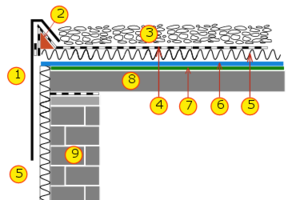Warm roof
A non-ventilated roof structure is called a warm roof , also known as a single-shell roof . With this type of roof, the roof skin is applied directly to the insulation layer. The thermal insulation is protected from the moisture diffusing through the ceiling downwards, i.e. towards the room side, by a vapor barrier . If the thermal insulation is above the roof cladding, one speaks of an inverted roof .
Since air humidity occurs in every building that is used, it must be removed via suitable ventilation, otherwise the humidity can condense and lead to the formation of mold . If moisture collects in the thermal insulation , it loses its function.
In the past, warm roofs were mostly only preferred for flat roofs , for pitched roofs the cold roof , in which a ventilated air layer follows under the roof skin and only then the heat insulating layer. In the meantime, single-leaf roofs are generally recognized state of the art in both cases, since the previously problematic moisture curve in the roof component and the position of the dew point can be controlled with newer, suitable materials .
In winter, the insulation effect of the warm roof is similar to that of the cold roof (with the same insulation material thickness). In summer, however, the roof surface lying in the sun often becomes warmer than the outside air due to the direct and diffuse solar radiation. The insulation layer forms a resistance for the heat flow, which is induced by the temperature difference between the innermost and outermost component layers. Due to the reduced thermal conductivity of the insulation layer, there are smaller temperature fluctuations in the living space than outdoors. The thermal conductivity of the insulation layer and the underlying structure ensure that the temperature peaks are delayed . In the case of a cold roof, on the other hand, there is a ventilation zone between the roof surface and the insulation, which in the best case only has the air temperature (shadow temperature ) with good ventilation . The insulation material has to withstand a lower temperature difference, but a more constant heat flow due to the much higher storage mass of the solid ceiling in contrast to the insulation layer. For this reason, a distinction is made between buildings with cold roofs and buildings with warm roofs based on the summer temperature profiles on the top floor. With a cold roof, the insulation layer lies in the shadow of the roof surface, regardless of whether it is a flat roof or a pitched roof, but the building puts itself in the shade, however, it induces a high convective heat flow along the roof skin. This reduces both the heat transfer resistance of the roof skin and the fact that the time of the higher outside and inside temperature is influenced by the storage mass of the roof surface lying in the sun.
See also
Individual evidence
- ↑ Single-shell, non-ventilated roof, warm roof . Website build.de. Retrieved May 8, 2015.
- ↑ Cold roof . Wikipedia. Retrieved May 8, 2015.
- ↑ Dr. Ralf Plug: Calculation of the heat protection. Accessed July 15, 2019 (German).
- ↑ Häupl, et al .: Textbook of Building Physics: Sound - Heat - Humidity - Light - Fire - Climate . Ed .: Wolfgang Willems. 8th edition. Wiesbaden, ISBN 978-3-658-16074-6 .
